Reporting transactions to FINTRAC: The 24‑hour rule : FINTRAC’s compliance guidance
Updated on October 23, 2023
From: Financial Transactions and Reports Analysis Centre of Canada (FINTRAC)
Overview
This guidance came into effect on June 1, 2021.
This guidance describes when reporting entities must consider multiple transactions made within a 24‑hour period as a “single transaction”. This concept is referred to as “the 24‑hour rule”.
Currently, this guidance applies only to:
- large virtual currency transactions (since June 1, 2021)
- large cash transactions (since October 21, 2023)
For electronic funds transfers or casino disbursements, reporting entities should continue to apply the 24‑hour rule as outlined in FINTRAC policy interpretation 4 – The 24‑hour rule (pre-June 1, 2021) until the new reporting forms become available.
Further details can be found in the Notice on forthcoming regulatory amendments and flexibility.
Note
- Throughout this guidance, references to dollar amounts (such as $10,000) are in Canadian dollars or its equivalent in foreign currency or virtual currency.
- The examples in this guidance are meant to help explain reporting requirements. The details used in these examples such as names of persons, names of entities, addresses, phone numbers and email addresses are fictitious.
In this guidance
- 1. Who must comply
- 2. The 24‑hour rule explained
- 3. Determining the 24‑hour window
- 4. Reporting under the 24‑hour rule
- 5. Exceptions to the 24‑hour rule
- Annex A: Examples of the 24‑hour rule applied to electronic funds transfers
- Annex B: Examples of the 24‑hour rule applied to large cash transactions
- Annex C: Examples of the 24‑hour rule applied to large virtual currency transactions
- Annex D: Examples of the 24‑hour rule applied to casino disbursements
- Details and history
- For assistance
Related links
Related acts and regulations
Related guidance
- Reporting large cash transactions to FINTRAC
- Reporting large virtual currency transactions to FINTRAC
- Reporting casino disbursements to FINTRAC (publication date of this new guidance has not been confirmed yet)
- Reporting electronic funds transfers to FINTRAC (publication date of this new guidance has not been confirmed yet)
Related resources
1. Who must comply
All reporting entities must comply with the 24‑hour rule as required by the Proceeds of Crime (Money Laundering) and Terrorist Financing Act and associated Regulations.
2. The 24‑hour rule explained
The 24‑hour rule applies to these transaction types:
- large cash transactions
- large virtual currency transactions
- electronic funds transfers
- casino disbursements
The 24‑hour rule is the requirement to aggregate multiple transactions that are the same transaction type when they:
- total $10,000 or more together
- have been made within a consecutive 24‑hour window, and
- have the same aggregation type (conductor, beneficiary or on behalf of (third party))
For more information on the specific aggregation types for each transaction type, please refer to 4. Reporting under the 24‑hour rule.
Note: The 24 hours that make up the period must be consecutive. The period cannot exceed 24 hours.
Legal references
- Proceeds of Crime (Money Laundering) and Terrorist Financing Regulations, SOR/2002-184, subsections 126, 127, 128, 129, and 130
Transaction amounts
You must aggregate transactions of any amount (at, below or above $10,000), under the 24‑hour rule, if together these transactions:
- total $10,000 or more within a 24‑hour window and
- fall under the same aggregation type (for example, conductor) for the same transaction type (for example, large cash transaction)
You must aggregate and submit all transactions that meet the 24‑hour rule in the same report.
Before June 1, 2021, you were required to aggregate transactions less than $10,000 each that totalled $10,000 or more within a 24‑hour window in the same report. For transactions at or above $10,000 or more in this same 24‑hour period, you were required to report these separately. The table below compares this difference.
| Transactions in a 24‑hour window that total $10,000 or more | Aggregate transactions in a single report | |
|---|---|---|
| Before June 1, 2021 | As of June 1, 2021 | |
| 2 or more transactions under $10,000 | Yes | Yes |
| 1 or more transactions under $10,000 and 1 or more transactions at $10,000 or more | No | Yes |
| 2 or more transactions at $10,000 or more | No | Yes |
Note: Although the regulatory change came into effect on June 1, 2021, reporting entities are not able to apply this change until the new reporting forms are available on the following dates:
- Large Virtual Currency Transaction Report form – available June 1, 2021
- Large Cash Transaction Report form – available October 21, 2023
- Electronic Funds Transfer Report form – date to be determined
- Casino Disbursement Report form – date to be determined
Multiple locations
If you have multiple locations (for example, various locations in cities or provinces across Canada), you should consider the 24‑hour rule broadly across your business. When transactions occur at multiple business locations in a 24‑hour window, you must report them in accordance with the 24‑hour rule.
Your business process
Your business must have a process in place to review and aggregate transactions in accordance with the 24‑hour rule requirement. This process should be documented in your Compliance policies and procedures to ensure consistent aggregation, including if the same person or entity has multiple roles in a transaction. Specifically, there may be transactions where:
- the conductor/requestor and beneficiary are the same, or
- the on behalf of party (third party) and beneficiary are the same
For example, when a person deposits cash into their own account, this person is both the conductor and beneficiary. This may result in some reports having the same transactions.
For more information:
3. Determining the 24‑hour window
You must determine the beginning and the end of your 24‑hour window to identify the transactions that need to be aggregated and reported under the 24‑hour rule. This window is called a static 24‑hour window. For example, 9 am Monday to 8:59 am Tuesday.
You are not limited to one 24‑hour window for all of your business lines. You have the option of using different static 24‑hour windows for different transaction types or different business lines. For example, you may determine that for operational purposes you will use a 12 am Monday to 11:59 pm Monday static 24‑hour window for wire transfers, but for cash transactions you choose to use a different 24‑hour window, such as 8 pm Monday to 7:59 pm Tuesday.
Each transaction that falls under the 24‑hour rule within a static 24‑hour window will have to be viewed independently from the previous or subsequent static 24‑hour window. This means that one transaction cannot overlap multiple 24‑hour windows.
It is important to note that while you will monitor transactions for the applicability of the 24‑hour rule within a static 24‑hour window, you must also monitor all transactions, regardless of the static 24‑hour window, to identify suspicious transactions that could relate to money laundering or terrorist activity financing. For more information, refer to Reporting suspicious transactions to FINTRAC.
Your policies and procedures should include the time when your 24‑hour windows begin and end. You will also need to indicate the times that your 24‑hour window begins and ends in a mandatory field when you submit a report to FINTRAC.
4. Reporting under the 24‑hour rule
The 24‑hour rule applies to all reports that have a reporting threshold of $10,000. The requirements for each type of report are outlined below.
Large Cash Transaction Report
Reporting entities have the obligation to report large cash transactions to FINTRAC in accordance with the 24‑hour rule when 2 or more amounts in cash are received that total $10,000 or more within a static 24‑hour window, and the reporting entity knows that those transactions:
- were conducted by the same person or entity
- were conducted on behalf of the same person or entity (third party), or
- are for the same beneficiary (person or entity)
Other requirements and exceptions apply. For more information, refer to:
- Reporting large cash transactions to FINTRAC, and
- Annex B – Examples of the 24‑hour rule applied to large cash transactions
Legal reference
- Proceeds of Crime (Money Laundering) and Terrorist Financing Regulations, SOR/2002-184, subsections 126(a) to (c)
Large Virtual Currency Transaction Report
Reporting entities have the obligation to report large virtual currency transactions to FINTRAC in accordance with the 24‑hour rule when 2 or more amounts are received in virtual currency that total $10,000 or more within a static 24‑hour window, and the reporting entity knows that those transactions:
- were conducted by the same person or entity
- were conducted on behalf of the same person or entity (third party), or
- are for the same beneficiary (person or entity)
Other requirements and exceptions apply. For more information, refer to:
- Reporting large virtual currency transactions to FINTRAC
- Annex C – Examples of the 24‑hour rule applied to large virtual currency transactions
- Exceptions to the 24‑hour rule – Large Virtual Currency Transaction Report
Legal reference
- Proceeds of Crime (Money Laundering) and Terrorist Financing Regulations, SOR/2002-184, subsections 129(1)(a) to (c)
Electronic Funds Transfer Report
Financial entities, money services businesses, foreign money services businesses and casinos must report electronic funds transfers to FINTRAC in accordance with the 24‑hour rule when they:
- initiate 2 or more international electronic funds transfers that total $10,000 or more within a static 24‑hour window, and the reporting entity knows that the transactions:
- were requested by the same person or entity
- were requested on behalf of the same person or entity (third party), or
- are for the same beneficiary (person or entity)
- finally receive 2 or more international electronic funds transfers that total $10,000 or more within a static 24‑hour window, and the reporting entity knows that the transactions:
- were requested by the same person or entity, or
- are for the same beneficiary (person or entity)
Other requirements and exceptions apply. For more information, refer to:
- Reporting electronic funds transfers to FINTRAC (publication date of this new guidance has not been confirmed yet)
- Annex A: Examples of the 24‑hour rule applied to electronic funds transfers
- Exceptions to the 24‑hour rule – Electronic Funds Transfer Report
Legal reference
- Proceeds of Crime (Money Laundering) and Terrorist Financing Regulations, SOR/2002-184
- subsections 127(1)(a) to (c)
- subsections 128(1)(a) to (b)
Casino Disbursement Report
Casinos must report a casino disbursement to FINTRAC in accordance with the 24‑hour rule when 2 or more disbursements are made that total $10,000 or more, within a static 24‑hour window, and the casino knows that those disbursements are:
- requested by the same person or entity
- received by the same person or entity
- requested on behalf of the same person or entity, or
- received on behalf of the same person or entity
Other requirements and exceptions apply. For more information, refer to:
- Reporting casino disbursements to FINTRAC (publication date of this new guidance has not been confirmed yet)
- Annex D: Examples of the 24‑hour rule applied to casino disbursements
Legal reference
- Proceeds of Crime (Money Laundering) and Terrorist Financing Regulations, SOR/2002-184, subsections 130(a) to (d)
Reports where all transactions are the same
This occurs when 2 or more reports contain transactions that are all the same. The reports contain the exact same transaction information and only the aggregation type is different.
When this occurs, you may choose to send only 1 of the reports to FINTRAC.
Example
In a static 24‑hour window, the following 2 transactions occur:
- Transaction reference number 101: Henry deposits $8,000 cash into his account at ABC Bank. Henry is the conductor and beneficiary.
- Transaction reference number 102: Henry deposits $6,000 cash into his account at ABC Bank. Henry is the conductor and beneficiary.
Report 1 – Aggregation by conductor (Henry): This report includes transaction reference number 101 for $8,000 and transaction reference number 102 for $6,000 totaling $14,000.
Report 2 – Aggregation by beneficiary (Henry): This report includes transaction reference number 101 for $8,000 and transaction reference number 102 for $6,000 totaling $14,000.
Reports 1 and 2 can both be submitted to FINTRAC—one aggregated by “conductor” and the other aggregated by “beneficiary”. However, because reports 1 and 2 contain the exact same transactions, ABC Bank may choose to send only 1 of these reports to FINTRAC. ABC Bank should document their chosen process to ensure consistent reporting.
Only when the transactions are all exactly the same but have different aggregation types (conductor and beneficiary for example) can a reporting entity choose to submit only 1 report based on 1 aggregation type.
Note: Depending on your business systems and processes, the transaction reference number (the unique number you assign to each transaction) may help you recognize the same transactions occurring in multiple reports. In the example above, transaction reference numbers 101 and 102 occur in both reports, indicating that there may be the same transactions in reports 1 and 2.
Reports where some transactions are the same
This happens when 2 or more reports contain some transactions that are the same, but not all are the same. These reports have different aggregation types and contain some transactions, but not all, which overlap.
When this happens, you cannot choose which report to submit. You must submit all reports to FINTRAC.
Example
In a static 24‑hour window, the following 3 transactions occur:
- Transaction reference number 103: Ted deposits $8,000 cash into his account at ABC Bank. Ted is the conductor and beneficiary.
- Transaction reference number 104: Ted deposits $6,000 cash into Sally’s account at ABC Bank. Ted is the conductor and Sally is the beneficiary.
- Transaction reference number 105: Sally deposits $5,000 cash into Ted’s account at ABC Bank. Sally is the conductor and Ted is the beneficiary.
Report 1 – Aggregation by conductor (Ted): This report includes transaction reference number 103 for $8,000 and transaction reference number 104 for $6,000 totaling $14,000.
Report 2 – Aggregation by beneficiary (Ted): This report includes transaction reference number 103 for $8,000 and transaction reference number 105 for $5,000 totaling $13,000.
Reports 1 and 2 must both be submitted to FINTRAC—one aggregated by “conductor” and the other aggregated by “beneficiary”. Although both reports include 1 transaction that is the same (transaction reference number 103), report 1 contains an additional transaction (transaction reference number 104) that is not in report 2. Report 2 contains an additional transaction (transaction reference number 105) that is not in report 1. Both reports contain a transaction that is the same, but each report also contains a transaction that is different. You must submit both reports to ensure FINTRAC receives information on all 3 transactions.
Note: Depending on your business systems and processes, the transaction reference number (the unique number you assign to each transaction) may help you recognize the same transactions occurring in multiple reports. In the example above, transaction reference number 103 occurs in both reports, indicating that there may be the same transaction in reports 1 and 2.
Single transaction(s) of $10,000 or more in a 24‑hour window
When you are reviewing transactions to determine if they have the same aggregation type (for example, conductor) and you come across a single transaction in the amount of $10,000 or more in a 24‑hour window, you must report this transaction in its own report to FINTRAC unless it can be aggregated with any other transaction(s).
However, if a transaction in the amount of $10,000 or more is being aggregated and reported with other transactions, then you do not need to report this transaction in its own report. That is, you do not need to report the transaction of $10,000 or more on its own in a separate report if it is included in another report that is being submitted to FINTRAC under the 24‑hour rule.
For examples, refer to:
- Annex B: Examples of the 24‑hour rule applied to large cash transactions (examples B.2 and B.5)
- Annex C: Examples of the 24‑hour rule applied to large virtual currency transactions (examples C.1 and C.2)
Instances where you must not aggregate
When a person or entity has different roles (conductor/requestor, on behalf of, or beneficiary) in different transactions, the requirement to aggregate transactions is not triggered.
For example, you must not aggregate transactions:
- when a transaction is conducted by a person (for example, Bob), and
- a second transaction is conducted by someone else on behalf of Bob
This is because both transactions are not conducted by the same person nor are they conducted on behalf of the same person. Instead, Bob is the conductor of the first transaction and the on behalf of party in the second transaction. If these transactions happened to be for the same beneficiary and the transactions totalled $10,000 or more, then these transactions would have to be aggregated based on the beneficiary.
Example 1
In a static 24‑hour window, the following transactions occur:
- Martha deposits $9,000 cash into Mike’s account.
- Iris deposits $4,000 on behalf of Martha into Tom’s account.
| Conductor | On behalf of (third party) | Beneficiary | Aggregation type | Amount ($) |
|---|---|---|---|---|
| Martha | None | Mike | Not applicable | 9,000 |
| Iris | Martha | Tom | Not applicable | 4,000 |
In this example, the 24‑hour rule is not applicable as none of the aggregation types are the same.
Example 2
In a static 24‑hour window, the following transactions occur:
- Martha deposits $9,000 cash into Mike’s account.
- Iris deposits $8,000 on behalf of Martha into Mike’s account.
| Conductor | On behalf of (third party) | Beneficiary | Aggregation type | Amount ($) |
|---|---|---|---|---|
| Martha | None | Mike | Beneficiary | 9,000 |
| Iris | Martha | Mike | Beneficiary | 8,000 |
In this example, the 24‑hour rule is applicable and you would submit a report with both transactions with the beneficiary as the aggregation type.
For more 24‑hour rule examples, refer to the annexes at the end of this guidance.
5. Exceptions to the 24‑hour rule
Large Virtual Currency Transaction Report
You do not have to submit a Large Virtual Currency Transaction Report when you receive 2 or more amounts of virtual currency for the same beneficiary that total $10,000 or more under the 24‑hour rule, if the beneficiary is:
- a public body
- a very large corporation or trust that has minimum net assets of $75 million on its last audited balance sheet, whose shares or units are traded on a Canadian stock exchange or a stock exchange designated under subsection 262(1) of the Income Tax Act and that operates in a country that is a member of the Financial Action Task Force, or
- an administrator of a pension fund that is regulated under federal or provincial legislation
You cannot apply this exception to amounts of virtual currency received for 1 of these beneficiaries under the 24‑hour rule, if 1 or more of the amounts is individually equivalent to $10,000 or more. In this scenario you must submit a separate Large Virtual Currency Transaction Report to FINTRAC for each amount that is individually equivalent to $10,000 or more, as the reporting threshold has been met with the individual transaction.
Note: Other obligations and related exceptions may apply. For more information, refer to your sector-specific guidance (“reporting” and “record keeping” requirements).
Legal references
- Proceeds of Crime (Money Laundering) and Terrorist Financing Regulations, SOR/2002-184, subsections 129(2)(a) to (c)
Electronic Funds Transfer Report
Initiation of international electronic funds transfers
You do not have to submit an Electronic Funds Transfer Report for the initiation of 2 or more international electronic funds transfers that total $10,000 or more under the 24‑hour rule if the electronic funds transfers are initiated at the request of or on behalf of:
- a public body
- a very large corporation or trust that has minimum net assets of $75 million on its last audited balance sheet, whose shares or units are traded on a Canadian stock exchange or a stock exchange designated under subsection 262(1) of the Income Tax Act and that operates in a country that is a member of the Financial Action Task Force, or
- an administrator of a pension fund that is regulated under federal or provincial legislation
You cannot apply this exception to international electronic funds transfers you initiate under the 24‑hour rule at the request of, or on behalf of, 1 of these entities, if 1 or more of the international electronic funds transfers is individually in an amount of $10,000 or more. In this scenario, you must submit a separate Electronic Funds Transfer Report to FINTRAC for each international electronic funds transfer that is individually in an amount of $10,000 or more, as the reporting threshold has been met with each individual transaction.
Note: Other obligations and related exceptions may apply. For more information, refer to your sector-specific guidance (“reporting” and “record keeping” requirements).
Legal references
- Proceeds of Crime (Money Laundering) and Terrorist Financing Regulations, SOR/2002-184, subsections 127(2)(a) to (c)
Final receipt of electronic funds transfers
You do not have to submit an Electronic Funds Transfer Report for the final receipt of 2 or more electronic funds transfers that total $10,000 or more under the 24‑hour rule if the beneficiary is:
- a public body
- a very large corporation or trust that has minimum net assets of $75 million on its last audited balance sheet, whose shares or units are traded on a Canadian stock exchange or a stock exchange designated under subsection 262(1) of the Income Tax Act and that operates in a country that is a member of the Financial Action Task Force or
- an administrator of a pension fund that is regulated under federal or provincial legislation
You cannot apply this exception to electronic funds transfers that you finally receive for 1 of these beneficiaries under the 24‑hour rule, if 1 or more of the electronic funds transfers is individually in an amount of $10,000 or more. In this scenario, you must submit a separate Electronic Funds Transfer Report to FINTRAC for each electronic funds transfer that is individually in an amount of $10,000 or more, as the reporting threshold has been met with each individual transaction.
Note: Other obligations and related exceptions may apply. For more information, refer to your sector-specific guidance (“reporting” and “record keeping” requirements).
Legal references
- Proceeds of Crime (Money Laundering) and Terrorist Financing Regulations, SOR/2002-184, subsections 128(2)(a) to (c)
Annex A – Examples of the 24‑hour rule applied to electronic funds transfers
Note: Examples for Annex A will be provided closer to the implementation of the new reporting form for electronic funds transfers.
Annex B – Examples of the 24‑hour rule applied to large cash transactions
Note: The examples used in this guidance are meant to help explain your reporting requirements. All details described in these examples such as names of persons, names of entities, addresses, phone numbers and email addresses are fictitious.
In this annex
- Example B.1: Receipt of cash – 24‑hour rule – Aggregation on the conductor and beneficiary where transactions are above $10,000
- Example B.2: Receipt of cash – 24‑hour rule – Aggregation on the conductor and beneficiary where transactions are above and below $10,000
- Example B.3: Receipt of cash – 24‑hour rule – Aggregation on the conductor and beneficiary with 1 transaction outside of the 24‑hour window
- Example B.4: Receipt of cash – 24‑hour rule – Aggregation on the beneficiary – Transactions occurring in different time zones
- Example B.5: Receipt of cash – 24‑hour rule – Aggregation on third party
- Example B.6: Receipt of cash – 24‑hour rule – Aggregation on conductor – Entity or person
Example B.1: Receipt of cash – 24‑hour rule – Aggregation on the conductor and beneficiary where transactions are above $10,000
Scenario
The 24‑hour window for the Large Cash Transaction Report process is from 12 am to 11:59 pm the same day.
- Transaction 01: Saturday at 11:30 am, Fancy Jewels Limited receives $14,000 cash from Jeremy who buys a diamond necklace.
- Transaction 02: Saturday at 1:40 pm, Fancy Jewels Limited receives $13,000 cash from Jeremy who buys a gold bracelet.
| 24‑hour window | Transaction reference number | Time of transaction | Disposition type | Amount ($) | Conductor | Beneficiary | Third party | Aggregation type |
|---|---|---|---|---|---|---|---|---|
| 12:00 am to 11:59 pm | 01 | 11:30 am | Purchase of Jewellery | 14,000 | Jeremy | Jeremy | None | Conductor and beneficiary |
| 02 | 1:40 pm | Purchase of Jewellery | 13,000 | Jeremy | Jeremy | None | Conductor and beneficiary |
Large Cash Transaction Report requirement
In this scenario, Fancy Jewels Limited would review all transactions that fall within the 24‑hour window to check if multiple transactions occurred for the same aggregation type that together total $10,000 or more. The dealer in precious metals and precious stones would notice:
- Transactions 01 and 02 were both conducted by Jeremy and total $27,000.
- Transactions 01 and 02 both have Jeremy as the beneficiary and total $27,000.
Fancy Jewels Limited submits 2 reports:
- Report 1: A Large Cash Transaction Report under the 24‑hour rule that includes 2 transactions (01 and 02) totalling an amount equivalent to $27,000 aggregated on the conductor, which is Jeremy.
- Report 2: A Large Cash Transaction Report under the 24‑hour rule that includes 2 transactions (01 and 02) totalling an amount equivalent to $27,000 aggregated on the beneficiary, which is Jeremy.
Both reports 1 and 2 can be submitted to FINTRAC—one where the aggregation type is “conductor” and the other where the aggregation type is “beneficiary”. However, because the transactions included in reports 1 and 2 are the same, Fancy Jewels Limited may choose to send only 1 of these reports to FINTRAC. Fancy Jewels Limited should document their chosen process to ensure consistent reporting.
Infographic summarizing example B.1
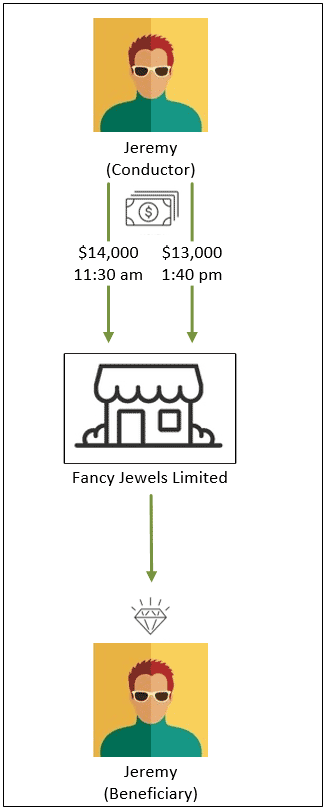
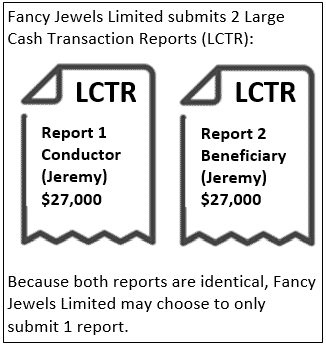
Example B.2: Receipt of cash – 24‑hour rule – Aggregation on the conductor and beneficiary where transactions are above and below $10,000
Scenario
The 24‑hour window for the Large Cash Transaction Report process is from 12:00 am to 11:59 pm the same day.
- Transaction 01: Wednesday at 9:20 am, Money Business Limited receives $5,000 cash from Eve to exchange into US dollars.
- Transaction 02: Wednesday at 12:08 pm, Money Business Limited receives $4,000 cash from Eve who provides instructions to send the amount to Sam in Italy.
- Transaction 03: Wednesday at 2:39 pm, Money Business Limited receives $11,000 cash from Eve who provides instructions to send the amount to Sam in Italy.
- Transaction 04: Wednesday at 4:55 pm, Money Business Limited receives $12,000 cash from Eve who provides instructions to send the amount to James in France.
| 24‑hour window | Transaction reference number | Time of transaction | Disposition type | Amount ($) | Conductor | Beneficiary | Third party | Aggregation type |
|---|---|---|---|---|---|---|---|---|
| 12:00 am to 11:59 pm | 01 | 9:20 am | Exchange to fiat currency | 5,000 | Eve | Eve | None | Conductor |
| 02 | 12:08 pm | Outgoing international funds transfer | 4,000 | Eve | Sam | None | Conductor and beneficiary | |
| 03 | 2:39 pm | Outgoing international funds transfer | 11,000 | Eve | Sam | None | Conductor and beneficiary | |
| 04 | 4:55 pm | Outgoing international funds transfer | 12,000 | Eve | James | None | Conductor |
Large Cash Transaction Report requirement
In this scenario, Money Business Limited would review all transactions that fall within their 24‑hour window to check if multiple transactions occurred for the same aggregation type that together total $10,000 or more. Money Business Limited would notice:
- Transactions 01, 02, 03 and 04 were all conducted by Eve and total $32,000.
- Transactions 02 and 03 both have Sam as the beneficiary and total $15,000.
- Money Business Limited submits 2 reports:
- Report 1: A Large Cash Transaction Report under the 24‑hour rule that includes 4 transactions (01, 02, 03 and 04) totalling an amount equivalent to $32,000 aggregated on the conductor, which is Eve.
- Report 2: A Large Cash Transaction Report under the 24‑hour rule that includes 2 transactions (02 and 03) totalling an amount equivalent to $15,000 aggregated on the beneficiary, which is Sam.
These 2 reports contain some transactions that are the same (transactions 02 and 03)—but some that are different. The first report aggregated by conductor also contains 2 additional transactions (transaction 01 and 04) that are not in the second report aggregated by beneficiary.
Transaction 03 (in the amount of $11,000) is over $10,000 but does not need to be reported in its own report, as this transaction has been included in report 1 that is aggregated by conductor and in report 2 that is aggregated by beneficiary.
Transaction 04 (in the amount of $12,000) is over $10,000 but does not need to be reported in its own report, as this transaction has been included in report 1 that is aggregated by conductor.
A transaction in the amount of $10,000 or more must be reported in its own report if the transaction has not been aggregated with other transactions in a 24‑hour window.
For more information, refer to:
Infographic summarizing example B.2
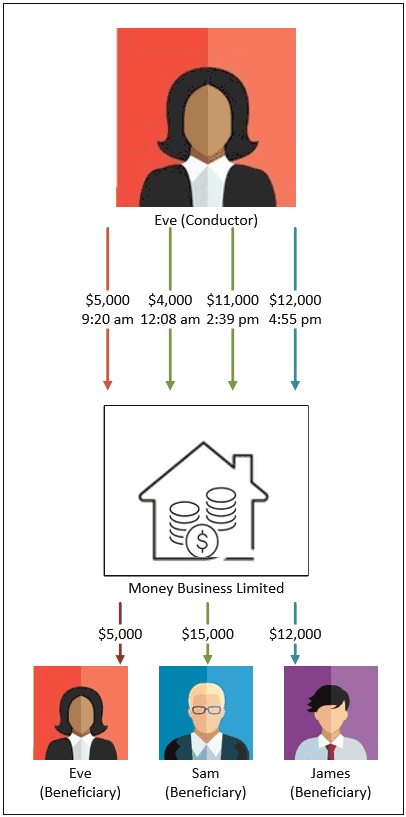
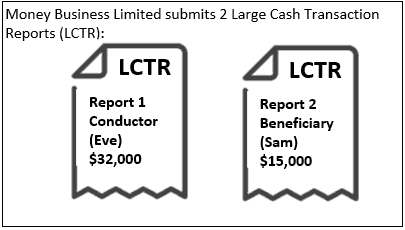
Example B.3: Receipt of cash – 24‑hour rule – Aggregation on the conductor and beneficiary with 1 transaction outside of the 24‑hour window
Scenario
The 24‑hour window for the Large Cash Transaction Report process is from 12 am to 11:59 pm the same day.
- Transaction 01: Monday at 11:55 am, Golden Bank receives $7,000 cash from Celine for deposit into James' account.
- Transaction 02: Monday at 3:15 pm, Golden Bank receives $6,000 cash from Eve for deposit into Irene's account.
- Transaction 03: Monday at 3:20 pm, Golden Bank receives $4,000 cash from Eve for deposit into James' account.
- Transaction 04: Monday at 5:08 pm, Golden Bank receives $3,000 cash from Sam for deposit into James' account.
- Transaction 05: Monday at 6:00 pm, Golden Bank receives $4,000 cash from Eve for deposit into James' account.
- Transaction 06: Tuesday at 8:30 am, Golden Bank receives $8,000 cash from Sam for deposit into James' account.
| 24‑hour window | Transaction reference number | Time of transaction | Disposition type | Amount ($) | Conductor | Beneficiary | Third party | Aggregation type |
|---|---|---|---|---|---|---|---|---|
| 12am to 11:59 pm (Monday) | 01 | 11:55 am | Deposit to an account | 7,000 | Celine | James | None | Beneficiary |
| 02 | 3:15 pm | Deposit to an account | 6,000 | Eve | Irene | None | Conductor | |
| 03 | 3:20 pm | Deposit to an account | 4,000 | Eve | James | None | Conductor and beneficiary | |
| 04 | 5:08 pm | Deposit to an account | 3,000 | Sam | James | None | Beneficiary | |
| 05 | 6:00 pm | Deposit to an account | 4,000 | Eve | James | None | Conductor and beneficiary | |
| 12 am to 11:59 pm (Tuesday) | 06 | 8:30 am | Deposit to an account | 8,000 | Sam | James | None | Not applicable |
Large Cash Transaction Report requirement
In this scenario, Golden Bank would review all transactions that fall within the 24‑hour window to check if multiple transactions occurred for the same aggregation type that together total $10,000 or more. The bank would notice:
- Transactions 02, 03 and 05 were all conducted by Eve and total $14,000.
- Transactions 01, 03, 04 and 05 all have James as the beneficiary and total $18,000.
Golden Bank submits 2 reports:
- Report 1:- A Large Cash Transaction Report under the 24‑hour rule that includes 3 transactions (02, 03 and 05) totalling an amount equivalent to $14,000 aggregated on the conductor, which is Eve.
- Report 2: A Large Cash Transaction Report under the 24‑hour rule that combines 4 transactions (01, 03, 04 and 05) totalling an amount equivalent to $18,000 aggregated on the beneficiary, which is James. Transaction 06 that occurred at 8:30 am on Tuesday where Sam is the conductor and James is the beneficiary is not included because it was conducted in the next 24‑hour window.
These 2 reports contain some transactions that are the same (transactions 03 and 05)—but some that are different. The first report aggregated by conductor contains 1 additional transaction (transaction 02) and the second report aggregated by beneficiary contains 2 additional transactions (transactions 01 and 04).
Infographic summarizing example B.3
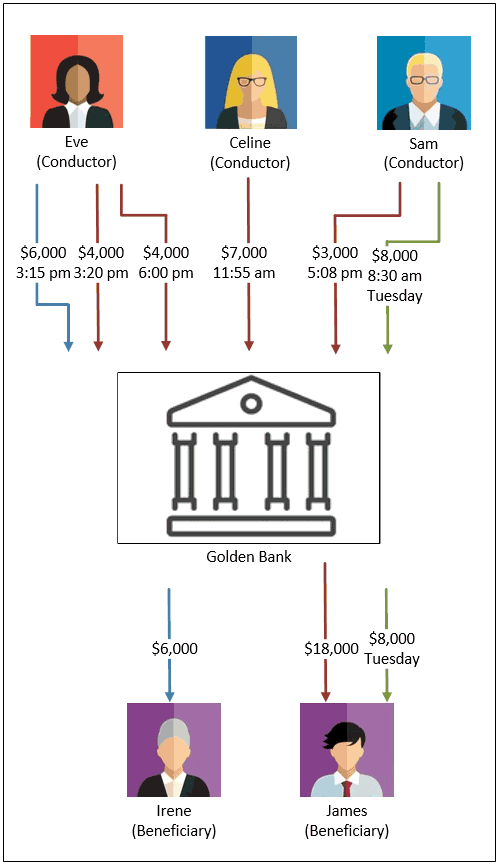
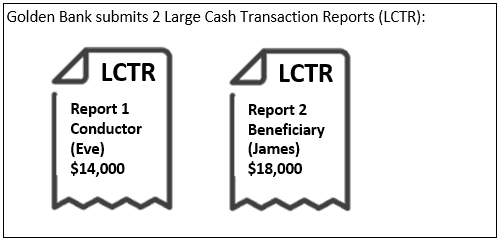
Example B.4: Receipt of cash – 24‑hour rule – Aggregation on the beneficiary – Transactions occurring in different time zones
Scenario
The 24‑hour window for the Large Cash Transaction Report process is from 12 am to 11:59 pm the same day based on Eastern Standard Time (EST).
- Transaction 01: Monday at 10:08 am EST, Golden Bank receives $7,000 cash from Celine in Ottawa for deposit into James’ account.
- Transaction 02: Monday at 11:43 am EST, Golden Bank receives $3,000 cash from Sam in Montreal for deposit into James’ account.
- Transaction 03: Monday at 5:10 pm Pacific Standard Time (PST), Golden Bank receives $2,000 cash from Sebastian in Victoria for deposit into James’ account.
- Transaction 04: Monday at 9:12 pm PST, Golden Bank receives $4,000 cash from Eve in Victoria for deposit into James’ account.
| 24‑hour window | Transaction reference number | Time of transaction | Disposition type | Amount ($) | Conductor | Beneficiary | Third party | Aggregation type |
|---|---|---|---|---|---|---|---|---|
| 12 am to 11:59 pm Eastern Standard Time (EST) (Monday) | 01 | 10:08 am EST | Deposit to an account | 7,000 | Celine | James | None | Beneficiary |
| 02 | 11:43 am EST | Deposit to an account | 3,000 | Sam | James | None | Beneficiary | |
| 03 | 5:10 pm Pacific Standard Time (PST), Monday (which equals to 8:10 pm EST, Monday) | Deposit to an account | 2,000 | Sebastian | James | None | Beneficiary | |
| 12 am to 11:59 pm EST (Tuesday) | 04 | 9:12 pm PST, Monday (which equals to 12:12 am EST, Tuesday) | Deposit to an account | 4,000 | Eve | James | None | Not applicable |
Large Cash Transaction Report requirement
In this scenario, Golden Bank has locations that are in 2 different time zones:
- Eastern Standard Time (Ottawa and Montreal)
- Pacific Standard Time (Victoria)
Because Golden Bank’s time zone for its 24‑hour window is based on Eastern Standard Time, it must convert the time of any transaction that occurs in Pacific Standard Time to Eastern Standard Time to confirm if it falls within its 24‑hour window. Golden Bank would then review all transactions that fall within the 24‑hour window to check if multiple transactions occurred for the same aggregation type that together total $10,000 or more. The bank would notice:
- Transactions 01, 02 and 03 all have James as the beneficiary and total $12,000 and occur in the same 24‑hour window even though they all are conducted at locations with different time zones.
- Transaction 04 for $4,000 also has James as the beneficiary but it does not occur in the same 24‑hour window as transactions 01, 02 and 03.
Golden Bank submits 1 report:
- Report 1: A Large Cash Transaction Report under the 24‑hour rule that includes 3 transactions (01, 02 and 03) totalling an amount equivalent to $12,000 aggregated on the beneficiary, which is James. Although James is also the beneficiary of transaction 04, it is not aggregated with transactions 01, 02 and 03 because it was conducted on Monday at 9:12 pm Pacific Standard Time (which equals to 12:12 am Eastern Standard Time, Tuesday) and therefore falls in the next 24‑hour window.
Infographic summarizing example B.4

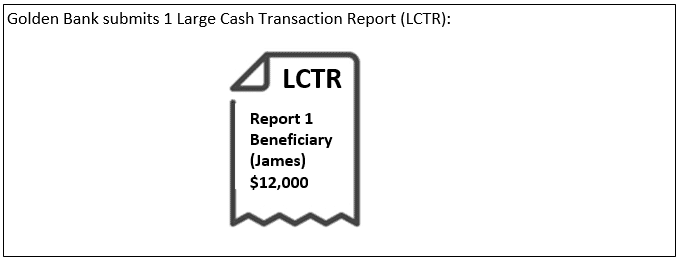
Example B.5: Receipt of cash – 24‑hour rule – Aggregation on third party
Scenario
The 24‑hour window for the Large Cash Transaction Report process is from 12 am to 11:59 pm the same day.
- Transaction 01: Friday at 11:12 am, Credit Union Inc. receives $12,000 cash from Eve for deposit into James’ account. The credit union knows that Eve conducted the transaction on behalf of Celine.
- Transaction 02: Friday at 1:32 pm, Credit Union Inc. receives $4,000 cash from James for deposit into Eve’s account. The credit union knows that James conducted the transaction on behalf of Celine.
| 24‑hour window | Transaction reference number | Time of transaction | Disposition type | Amount ($) | Conductor | Beneficiary | Third party | Aggregation type |
|---|---|---|---|---|---|---|---|---|
| 12 am to 11:59 pm | 01 | 11:12 am | Deposit to an account | 12,000 | Eve | James | Celine | Third party |
| 02 | 1:32 pm | Deposit to an account | 4,000 | James | Eve | Celine | Third party |
Large Cash Transaction Report requirement
In this scenario, Credit Union Inc. would review all transactions that fall within the 24‑hour window to check if multiple transactions occurred for the same aggregation type that together total $10,000 or more. The credit union would notice:
- Transactions 01 and 02 were both conducted on behalf of Celine (third party) and total $16,000.
Credit Union Inc. submits 1 report:
- Report 1: A Large Cash Transaction Report under the 24‑hour rule that includes two transactions (01 and 02) totalling an amount equivalent to $16,000 aggregated on the third party, which is Celine.
Transaction 01 (in the amount of $12,000) is over $10,000 but does not need to be reported in its own report, as this transaction has been included in report 1 that is aggregated by third party.
A transaction in the amount of $10,000 or more must be reported in its own report if the transaction has not been aggregated with other transactions in a 24‑hour window.
For more information, refer to:
Infographic summarizing example B.5

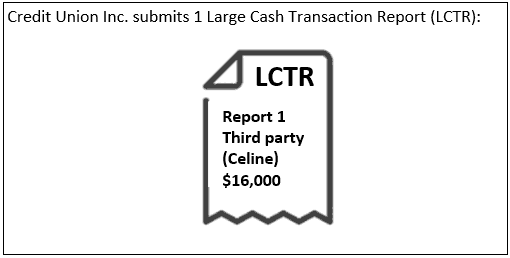
Example B.6: Receipt of cash – 24‑hour rule – Aggregation on conductor – Entity or person
Scenario
The 24‑hour window for the Large Cash Transaction Report process is from 12 am to 11:59 pm the same day.
- Transaction 01: Wednesday at 1:30 pm, Golden Bank receives $5,000 cash from Yara who is the President of The Rosie Kitchen Supply Company for exchange into US dollars. Golden Bank asks Yara if she is conducting this transaction in her capacity as the President of The Rosie Kitchen Supply Company. Yara confirms that she is acting in her capacity as the President of The Rosie Kitchen Supply Company for this transaction. Yara is therefore understood to be acting as the entity (Rosie Kitchen Supply Company).
- Transaction 02: Wednesday at 1:40 pm, Golden Bank receives $6,000 cash from Yara for exchange into Japanese Yen. Golden Bank asks Yara if she is conducting this transaction in her capacity as the President of The Rosie Kitchen Supply Company. Yara advises that she is not conducting this transaction in her capacity as the President of The Rosie Kitchen Supply Company as the exchange is for her personal vacation to Japan. Yara is therefore understood to be acting as a person.
- Transaction 03: Wednesday at 3:05 pm, Golden Bank receives $8,000 cash from Yara who requests that the amount be transferred to The Blueberry Company in Toronto. Golden Bank asks Yara if she is conducting this transaction in her capacity as the President of The Rosie Kitchen Supply Company. Yara advises that she is conducting this transaction in her capacity as the President of The Rosie Kitchen Supply Company. Yara is therefore understood to be acting as the entity (Rosie Kitchen Supply Company).
| 24‑hour window | Transaction reference number | Time of transaction | Disposition type | Amount ($) | Conductor | Beneficiary | Third party | Aggregation type |
|---|---|---|---|---|---|---|---|---|
| 12 am to 11:59 pm | 01 | 1:30 pm | Exchange to fiat currency | 5,000 | The Rosie Kitchen Supply Company | The Rosie Kitchen Supply Company | None | Conductor |
| 02 | 1:40 pm | Exchange to fiat currency | 6,000 | Yara | Yara | None | Not applicable | |
| 03 | 3:05 pm | Outgoing domestic funds transfer | 8,000 | The Rosie Kitchen Supply Company | The Blueberry Company | None | Conductor |
Large Cash Transaction Report requirement
Business practice to treat an entity as the conductor
In this scenario, Golden Bank has a business practice (which is explained in its policies and procedures) to treat an entity as the conductor when the President (or Chief Executive Officer) of an entity conducts a transaction and Golden Bank is aware that the individual is acting as the entity in their capacity as the President. This business practice is in line with FINTRAC’s policy interpretation that an entity can only conduct a transaction by means of a physical person, and when that person is the President, Chief Executive Officer, or someone who holds an equivalent position within the entity, they can be considered to be acting as the entity. Golden Bank would review all transactions that fall within the 24‑hour window to check if multiple transactions occurred for the same aggregation type that together total $10,000 or more. It would notice:
- Transactions 01 and 03 were both conducted by The Rosie Kitchen Supply Company and total $13,000.
Golden Bank submits 1 report:
- Report 1: A Large Cash Transaction Report under the 24‑hour rule that includes 2 transactions (01 and 03) totalling an amount equivalent to $13,000 aggregated on the conductor, which is The Rosie Kitchen Supply Company.
Business practice to treat a person (individual) as the conductor
If Golden Bank has instead a business practice (which is explained in its policies and procedures) to treat a person (individual) as the conductor, regardless of the person’s role, then the bank would notice that transactions 01, 02 and 03 were all conducted by Yara and total $19,000. The Bank would also notice that transactions 01 and 03 were conducted by Yara on behalf of The Rosie Kitchen Supply Company and total $13,000.
| 24‑hour window | Transaction reference number | Time of transaction | Disposition type | Amount ($) | Conductor | Beneficiary | Third party | Aggregation type |
|---|---|---|---|---|---|---|---|---|
| 12 am to 11:59 pm | 01 | 1:30 pm | Exchange to fiat currency | 5,000 | Yara | The Rosie Kitchen Supply Company | The Rosie Kitchen Supply Company | Conductor |
| 02 | 1:40 pm | Exchange to fiat currency | 6,000 | Yara | Yara | None | Conductor | |
| 03 | 3:05 pm | Outgoing domestic funds transfer | 8,000 | Yara | The Blueberry Company | The Rosie Kitchen Supply Company | Conductor |
Golden Bank submits 2 reports:
- Report 1: A Large Cash Transaction Report under the 24‑hour rule that includes 3 transactions (01, 02 and 03) totalling an amount equivalent to $19,000 aggregated on the conductor, which is Yara.
- Report 2: A Large Cash Transaction Report under the 24‑hour rule that includes 2 transactions (01 and 03) totalling an amount equivalent to $13,000 aggregated on the third party, which is The Rosie Kitchen Supply Company.
These 2 reports contain some transactions that are the same (transactions 01 and 03), but some that are different. The first report aggregated by conductor contains 1 additional transaction (transaction 02) that is not in the second report aggregated by third party.
Infographics summarizing example B.6
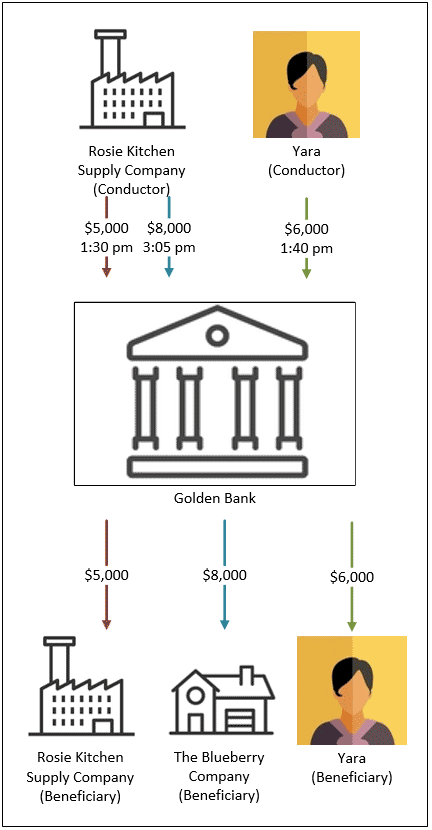
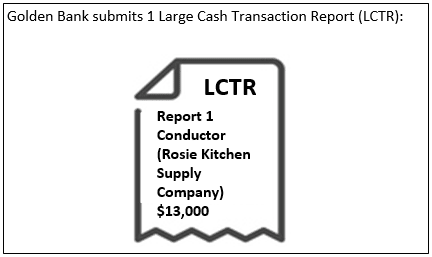
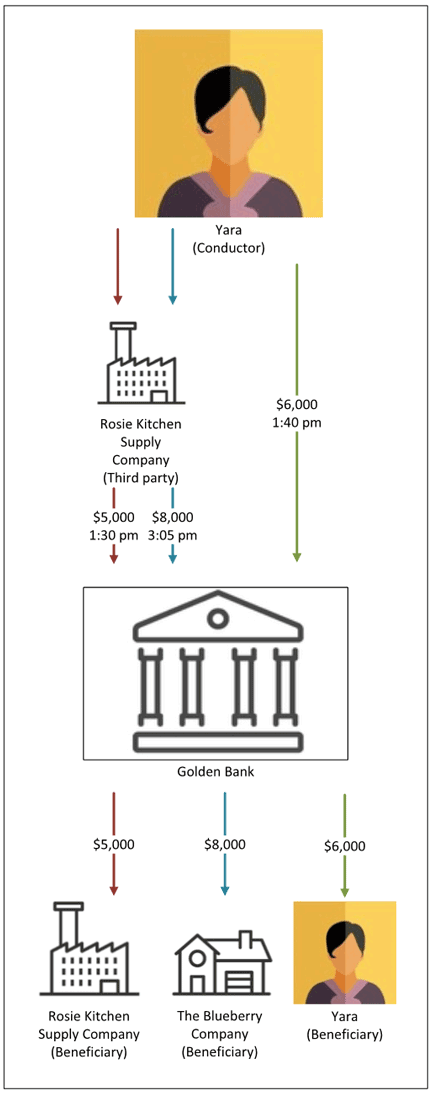

Annex C – Examples of the 24‑hour rule applied to large virtual currency transactions
Note: The examples used in this guidance are meant to help explain your reporting requirements. All details described in these examples such as names of persons, names of entities, addresses, phone numbers and email addresses are fictitious.
In this annex
Assumptions for the 3 examples
- General Coin Company is a money services business that deals in virtual currency and is subject to the Proceeds of Crime (Money Laundering) and Terrorist Financing Act and associated Regulations.
- General Coin Company's 24‑hour window for their Large Virtual Currency Transaction Report process is from 12 am to 11:59 pm the same day.
- The exchange rate for the virtual currency is 1 for $1,000 CDN.
Example C.1: Receipt of virtual currency – 24‑hour rule – Aggregation on the conductor
Scenario
- Transaction 01: Wednesday at 2:20 am, General Coin Company receives 2 virtual currency (equivalent to $2,000) from Eve to be added to James' virtual currency wallet.
- Transaction 02: Wednesday at 11:08 am, General Coin Company receives 4 virtual currency (equivalent to $4,000) from Eve to be added to Sam's virtual currency wallet.
- Transaction 03: Wednesday at 3:39 pm, General Coin Company receives 12 virtual currency (equivalent to $12,000) from Eve to be added to Celine's virtual currency wallet.
| 24‑hour window | Transaction reference number | Time of transaction | Disposition type | Amount (virtual currency) | Amount ($) | Conductor | Beneficiary | Third party | Aggregation type |
|---|---|---|---|---|---|---|---|---|---|
| 12 am to 11:59 pm | 01 | 2:20 am | Added to virtual currency wallet | 2 | 2,000 | Eve | James | None | Conductor |
| 02 | 11:08 am | Added to virtual currency wallet | 4 | 4,000 | Eve | Sam | None | Conductor | |
| 03 | 3:39 pm | Added to virtual currency wallet | 12 | 12,000 | Eve | Celine | None | Conductor |
Large Virtual Currency Transaction Report requirement
In this scenario, General Coin Company would review all transactions that fall within the 24‑hour window to check if multiple transactions occurred for the same aggregation type that together total $10,000 or more. The money services business would notice:
- Transactions 01, 02 and 03 were all conducted by Eve and total $18,000.
General Coin Company submits 1 report:
- Report 1: A Large Virtual Currency Transaction Report under the 24‑hour rule that includes the 3 transactions (01, 02, and 03) totalling an amount equivalent to $18,000 aggregated on the conductor, who is Eve.
Transaction 03 (in the amount of $12,000) is over $10,000 but does not need to be reported in its own report, as this transaction has been included in report 1 that is aggregated by conductor.
A transaction in the amount of $10,000 or more must be reported in its own report if the transaction has not been aggregated with any other transaction(s) in a 24‑hour window.
For more information, refer to:
Infographic summarizing example C.1
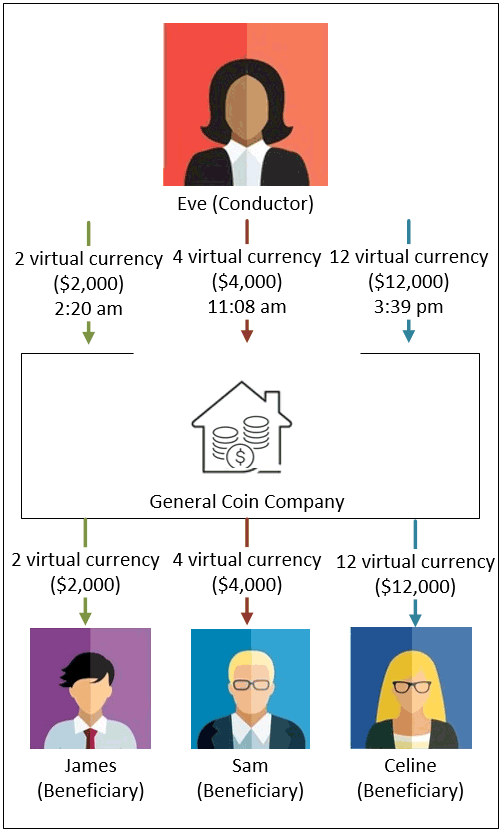
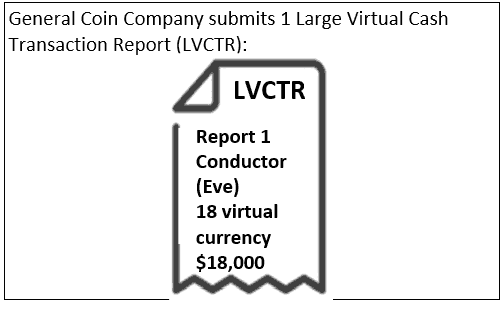
Example C.2: Receipt of virtual currency – 24‑hour rule – Aggregation on the beneficiary
Scenario
- Transaction 01: Monday at 7:39 am, General Coin Company receives 4 virtual currency (equivalent to $4,000) from Eve to be added to James' virtual currency wallet.
- Transaction 02: Monday at 1:15 pm, General Coin Company receives 6 virtual currency (equivalent to $6,000) from Celine to be added to James' virtual currency wallet.
- Transaction 03: Monday at 5:08 pm, General Coin Company receives 3 virtual currency (equivalent to $3,000) from Sam to be added to James' virtual currency wallet.
- Transaction 04: Monday at 5:11 pm, General Coin Company receives 2 virtual currency (equivalent to $2,000) from Sam to be added to Celine's virtual currency wallet.
- Transaction 05: Monday at 6:37 pm, General Coin Company receives 11 virtual currency (equivalent to $11,000) from Irene to be added to James' virtual currency wallet.
| 24‑hour window | Transaction reference number | Time of transaction | Disposition type | Amount (virtual currency) | Amount ($) | Conductor | Beneficiary | Third party | Aggregation type |
|---|---|---|---|---|---|---|---|---|---|
| 12 am to 11:59 pm | 01 | 7:39 am | Added to virtual currency wallet | 4 | 4,000 | Eve | James | None | Beneficiary |
| 02 | 1:15 pm | Added to virtual currency wallet | 6 | 6,000 | Celine | James | None | Beneficiary | |
| 03 | 5:08 pm | Added to virtual currency wallet | 3 | 3,000 | Sam | James | None | Beneficiary | |
| 04 | 5:11 pm | Added to virtual currency wallet | 2 | 2,000 | Sam | Celine | None | Not applicable | |
| 05 | 6:37 pm | Added to virtual currency wallet | 11 | 11,000 | Irene | James | None | Beneficiary |
Large Virtual Currency Transaction Report requirement
In this scenario, General Coin Company would review all transactions that fall within the 24‑hour window to check if multiple transactions occurred for the same aggregation type that together total $10,000 or more. The money services business would notice:
- Transactions 01, 02, 03 and 05 all have James as the beneficiary and total $24,000.
General Coin Company submits 1 report:
- Report 1: A Large Virtual Currency Transaction Report under the 24‑hour rule that includes the 4 transactions (01, 02, 03 and 05) totalling an amount equivalent to $24,000 aggregated on the beneficiary, who is James.
Transaction 05 (in the amount of $11,000) is over $10,000 but does not need to be reported in its own report, as this transaction has been included in report 1 that is aggregated by beneficiary.
A transaction in the amount of $10,000 or more must be reported in its own report if the transaction has not been aggregated with other transactions in a 24‑hour window.
For more information, refer to:
Infographic summarizing example C.2
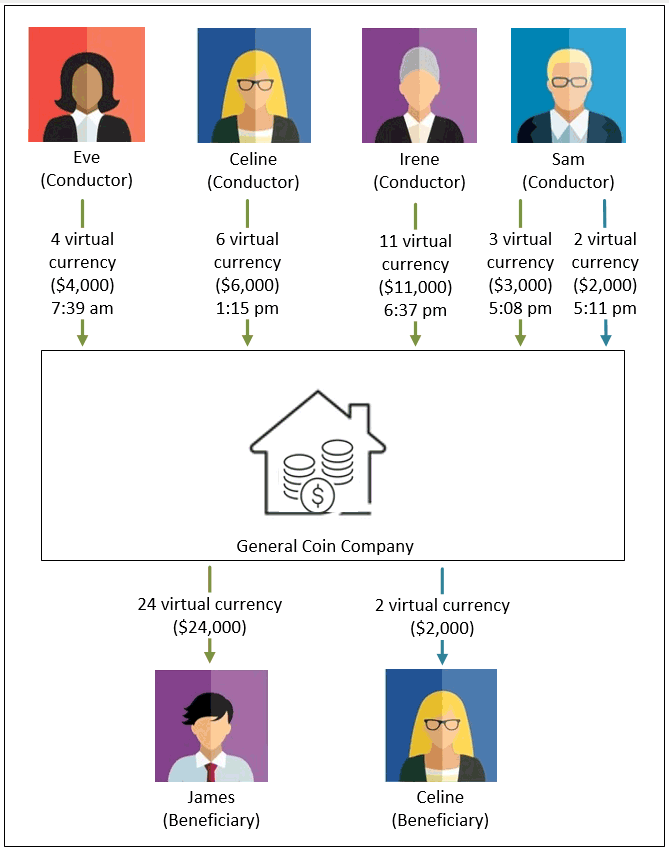
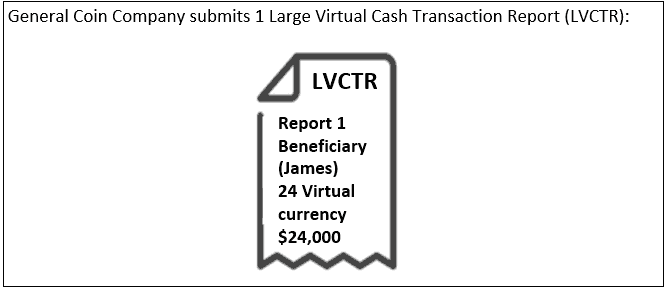
Example C.3: Receipt of virtual currency – 24‑hour rule – Aggregation on the third party
Scenario
- Transaction 01: Friday at 12:12 am, General Coin Company receives 8 virtual currency (equivalent to $8,000) from Eve to be added to James' virtual currency wallet. The money services business knows that Eve conducted the transaction on behalf of Celine.
- Transaction 02: Friday at 11:32 pm, General Coin Company receives 4 virtual currency (equivalent to $4,000) from James to be added to Eve's virtual currency wallet. The money services business knows that James conducted the transaction on behalf of Celine.
- Transaction 03: Saturday at 12:39 am, General Coin Company receives 2 virtual currency (equivalent to $2,000) from Eve to be added to James' virtual currency wallet. The money services business knows that Eve conducted the transaction on behalf of Celine.
| 24‑hour window | Transaction reference number | Time of transaction | Disposition type | Amount (virtual currency) | Amount ($) | Conductor | Beneficiary | Third party | Aggregation type |
|---|---|---|---|---|---|---|---|---|---|
| 12 am to 11:59 pm (Friday) | 01 | 12:12 am | Added to virtual currency wallet | 8 | 8,000 | Eve | James | Celine | Third party |
| 02 | 11:32 pm | Added to virtual currency wallet | 4 | 4,000 | James | Eve | Celine | Third party | |
| 12 am to 11:59 pm (Saturday) | 03 | 12:39 am | Added to virtual currency wallet | 2 | 2,000 | Eve | James | Celine | Not applicable |
Large Virtual Currency Transaction Report requirement
In this scenario, General Coin Company would review all transactions that fall within the 24‑hour window to check if multiple transactions occurred for the same aggregation type that together total $10,000 or more. The money services business would notice:
- Transactions 01 and 02 were conducted on behalf of Celine and total $12,000 and occurred on Friday.
- Transaction 03 was conducted on behalf of Celine and totalled $2,000 and occurred on Saturday—the next 24‑hour window.
General Coin Company submits 1 report:
- Report 1: A Large Virtual Currency Transaction Report under the 24‑hour rule that includes 2 transactions (01 and 02) totalling an amount equivalent to $12,000 aggregated on the third party, which is Celine. The transaction conducted on behalf of Celine on Saturday at 12:39 am for 2 virtual currency ($2,000) is not included because it occurred in the next 24‑hour window.
Infographic summarizing example C.3
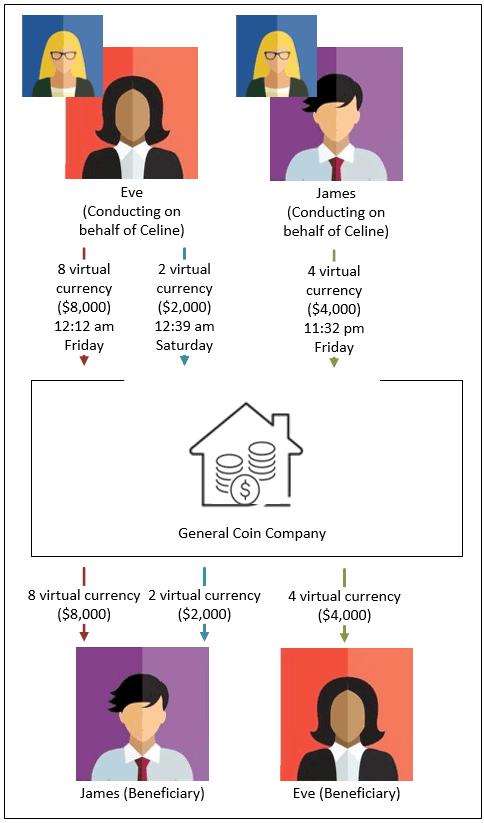
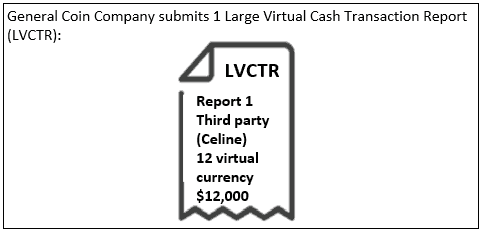
Annex D – Examples of the 24‑hour rule applied to casino disbursements
Note: Examples for Annex D will be provided closer to the implementation of the new reporting form for casino disbursements.
Details and history
Published: June 2021
| Date [YYYY-MM-DD] |
Summary of changes |
|---|---|
| 2023-10-23 |
|
For assistance
If you have questions about this guidance, please contact FINTRAC by email at guidelines-lignesdirectrices@fintrac-canafe.gc.ca.
Definitions
- Accountant
A chartered accountant, a certified general accountant, a certified management accountant or, if applicable, a chartered professional accountant. (comptable)
Reference:
Proceeds of Crime (Money Laundering) and Terrorist Financing Regulations (PCMLTFR), SOR/2002-184, s. 1(2).- Accounting firm
An entity that is engaged in the business of providing accounting services to the public and has at least one partner, employee or administrator that is an accountant. (cabinet d'expertise comptable)
Reference:
PCMLTFR, SOR/2002-184, s. 1(2).- Act
The Proceeds of Crime (Money Laundering) and Terrorist Financing Act (PCMLTFA). (la Loi)
Reference:
Proceeds of Crime (Money Laundering) and Terrorist Financing Administrative Monetary Penalties Regulations (PCMLTFAMPR), SOR/2007-292, s. 1, Proceeds of Crime (Money Laundering) and Terrorist Financing Registration Regulations (PCMLTFRR), SOR/2007-121, s. 1, PCMLTFR, SOR/2002-184, s. 1(2), and Proceeds of Crime (Money Laundering) and Terrorist Financing Suspicious Transaction Reporting Regulations (PCMLTFSTRR), SOR/2001-317, s. 1(2).- Administrative monetary penalties (AMPs)
Civil penalties that may be issued to reporting entities by FINTRAC for non-compliance with the PCMLTFA and associated Regulations. (pénalité administrative pécuniaire [PAP])
- Affiliate
An entity is affiliated with another entity if one of them is wholly owned by the other, if both are wholly owned by the same entity or if their financial statements are consolidated. (entité du même groupe)
Reference:
PCMLTFR, SOR/2002-184, s. 4.- Annuity
Has the same meaning as in subsection 248(1) of the Income Tax Act. (rente)
Reference:
PCMLTFR, SOR/2002-184, s. 1(2).- As soon as practicable
A time period that falls in-between immediately and as soon as possible, within which a suspicious transaction report (STR) must be submitted to FINTRAC. The completion and submission of the STR should take priority over other tasks. In this context, the report must be completed promptly, taking into account the facts and circumstances of the situation. While some delay is permitted, it must have a reasonable explanation. (aussitôt que possible)
- Attempted transaction
Occurs when an individual or entity starts to conduct a transaction that is not completed. For example, a client or a potential client walks away from conducting a $10,000 cash deposit. (opération tentée)
- Authentic
In respect of verifying identity, means genuine and having the character of an original, credible, and reliable document or record. (authentique)
- Authorized person
A person who is authorized under subsection 45(2). (personne autorisée)
Reference:
Proceeds of Crime (Money Laundering) and Terrorist Financing Act (PCMLTFA), S.C. 2000, c 17, s. 2(1).- Authorized user
A person who is authorized by a holder of a prepaid payment product account to have electronic access to funds or virtual currency available in the account by means of a prepaid payment product that is connected to it. (utilisateur autorisé)
Reference:
PCMLTFR, SOR/2002-184, s. 1(2).- Beneficial owner(s)
Beneficial owners are the individuals who are the trustees, and known beneficiaries and settlors of a trust, or who directly or indirectly own or control 25% or more of i) the shares of a corporation or ii) an entity other than a corporation or trust, such as a partnership. The ultimate beneficial owner(s) cannot be another corporation or entity; it must be the actual individual(s) who owns or controls the entity. (bénéficiaire effectif)
- Beneficiary
A beneficiary is the individual or entity that will benefit from a transaction or to which the final remittance is made. (bénéficiaire)
- Branch
A branch is a part of your business at a distinct location other than your main office. (succursale)
- British Columbia notary corporation
An entity that carries on the business of providing notary services to the public in British Columbia in accordance with the Notaries Act, R.S.B.C. 1996, c. 334. (société de notaires de la Colombie-Britannique)
Reference:
PCMLTFR, SOR/2002-184, s. 1(2).- British Columbia notary public
A person who is a member of the Society of Notaries Public of British Columbia. (notaire public de la Colombie-Britannique)
Reference:
PCMLTFR, SOR/2002-184, s. 1(2).- Cash
Coins referred to in section 7 of the Currency Act, notes issued by the Bank of Canada under the Bank of Canada Act that are intended for circulation in Canada or coins or bank notes of countries other than Canada. (espèces)
Reference:
PCMLTFR, SOR/2002-184, s. 1(2) and PCMLTFSTRR, SOR/2001-317, s. 1(2).- Casino
A government, organization, board or operator that is referred to in any of paragraphs 5(k) to (k.3) of the Act. (casino)
Reference:
PCMLTFR, SOR/2002-184, s 1(2) and PCMLTFSTRR, SOR/2001-317, s. 1(2).- Certified translator
An individual that holds the title of professional certified translator granted by a Canadian provincial or territorial association or body that is competent under Canadian provincial or territorial law to issue such certification. (traducteur agréé)
- Clarification request
A clarification request is a method used to communicate with money services businesses (MSBs) or foreign money services businesses (FMSBs) when FINTRAC needs more information about their registration form. This request is usually sent by email. (demande de précisions)
- Client
A person or entity that engages in a financial transaction with another person or entity. (client)
Reference:
PCMLTFA, S.C. 2000, c 17, s. 2(1).- Client identification information
The identifying information that you have obtained on your clients, such as name, address, telephone number, occupation or nature of principal business, and date of birth for an individual. (renseignements d'identification du client)
- Competent authority
For the purpose of the criminal record check submitted with an application for registration, a competent authority is any person or organization that has the legally delegated or invested authority, capacity, or power to issue criminal record checks. (autorité compétente)
- Completed transaction
Is a transaction conducted by a person or entity, that is completed and results in the movement of funds, virtual currency, or the purchase or sale of an asset. (opération effectuée)
- Completing action
With respect to a reportable transaction, information related to the instructions provided by the person or entity making the request to the reporting entity to complete a transaction. For example, an individual arrives at a bank and requests to purchase a bank draft. The completing action is the details of how the reporting entity fulfilled the person or entity’s instructions which led to the transaction being completed. This includes what the funds or virtual currency initially brought to the reporting entity was used for (see “disposition”). A transaction may have one or more completing actions depending on the instructions provided by the person or entity. (action d’achèvement)
- Compliance officer
The individual, with the necessary authority, that you appoint to be responsible for the implementation of your compliance program. (agent de conformité)
- Compliance policies and procedures
Written methodology outlining the obligations applicable to your business under the PCMLTFA and its associated Regulations and the corresponding processes and controls you put in place to address your obligations. (politiques et procédures de conformité)
- Compliance program
All elements (compliance officer, policies and procedures, risk assessment, training program, effectiveness review) that you, as a reporting entity, are legally required to have under the PCMLTFA and its associated Regulations to ensure that you meet all your obligations. (programme de conformité)
- Context
Clarifies a set of circumstances or provides an explanation of a situation or financial transaction that can be understood and assessed. (contexte)
- Correspondent banking relationship
A relationship created by an agreement or arrangement under which an entity referred to in any of paragraphs 5(a), (b), (d),(e) and (e.1) or an entity that is referred to in section 5 and that is prescribed undertakes to provide to a prescribed foreign entity prescribed services or international electronic funds transfers, cash management or cheque clearing services. (relation de correspondant bancaire)
Reference:
PCMLTFA, S.C. 2000, c 17, s. 9.4(3) and PCMLTFR, SOR/2002-184, s. 16(1)(b).- Country of residence
The country where an individual has lived continuously for 12 months or more. The individual must have a dwelling in the country concerned. For greater certainty, a person only has one country of residence no matter how many dwelling places they may have, inside or outside of that country. (pays de résidence)
- Credit card acquiring business
A credit card acquiring business is a financial entity that has an agreement with a merchant to provide the following services:
- enabling a merchant to accept credit card payments by cardholders for goods and services and to receive payments for credit card purchases;
- processing services, payment settlements and providing point-of-sale equipment (such as computer terminals); and
- providing other ancillary services to the merchant.
- Credit union central
A central cooperative credit society, as defined in section 2 of the Cooperative Credit Associations Act, or a credit union central or a federation of credit unions or caisses populaires that is regulated by a provincial Act other than one enacted by the legislature of Quebec. (centrale de caisses de crédit)
Reference:
PCMLTFR, SOR/2002-184, s. 1(2).- Crowdfunding platform
A website or an application or other software that is used to raise funds or virtual currency through donations. (plateforme de sociofinancement)
Reference:
PCMLTFR, SOR/2002-184, s. 1(2).- Crowdfunding platform services
The provision and maintenance of a crowdfunding platform for use by other persons or entities to raise funds or virtual currency for themselves or for persons or entities specified by them. (services de plateforme de sociofinancement)
Reference:
PCMLTFR, SOR/2002-184, s. 1(2).- Current
In respect of a document or source of information that is used to verify identity, is up to date, and, in the case of a government-issued photo identification document, must not have been expired when the ID was verified. (à jour)
- Dealer in precious metals and stones
A person or entity that, in the course of their business activities, buys or sells precious metals, precious stones or jewellery. It includes a department or an agent of His Majesty in right of Canada or an agent or mandatary of His Majesty in right of a province when the department or the agent or mandatary carries out the activity, referred to in subsection 65(1), of selling precious metals to the public. (négociant en métaux précieux et pierres précieuses)
Reference:
PCMLTFR, SOR/2002-184, s. 1(2).- Deferred profit sharing plan
Has the same meaning as in subsection 248(1) of the Income Tax Act. (régime de participation différée aux bénéfices)
Reference:
PCMLTFR, SOR/2002-184, s. 1(2).- Deposit slip
A record that sets out:
- (a) the date of the deposit;
- (b) the name of the person or entity that makes the deposit;
- (c) the amount of the deposit and of any part of it that is made in cash;
- (d) the method by which the deposit is made; and
- (e) the number of the account into which the deposit is made and the name of each account holder.
Reference:
PCMLTFR, SOR/2002-184, s. 1(2).- Directing services
A business is directing services at persons or entities in Canada if at least one of the following applies:
- The business's marketing or advertising is directed at persons or entities located in Canada;
- The business operates a ".ca" domain name; or,
- The business is listed in a Canadian business directory.
Additional criteria may be considered, such as if the business describes its services being offered in Canada or actively seeks feedback from persons or entities in Canada. (diriger des services)
- Distributed ledger
For the purpose of section 151 of the Proceeds of Crime (Money Laundering) and Terrorist Financing Regulations (PCMLTFR), a digital ledger that is maintained by multiple persons or entities and that can only be modified by a consensus of those persons or entities. (registres distribués)
Reference:
PCMLTFR, SOR/2002-184, s. 151(2).- Disposition
With respect to a reportable transaction, the disposition is what the funds or virtual currency was used for. For example, an individual arrives at a bank with cash and purchases a bank draft. The disposition is the purchase of the bank draft. (répartition)
- Electronic funds transfer
The transmission—by any electronic, magnetic or optical means—of instructions for the transfer of funds, including a transmission of instructions that is initiated and finally received by the same person or entity. In the case of SWIFT messages, only SWIFT MT-103 messages and their equivalent are included. It does not include a transmission or instructions for the transfer of funds:
- (a) that involves the beneficiary withdrawing cash from their account;
- (b) that is carried out by means of a direct deposit or pre-authorized debit;
- (c) that is carried out by cheque imaging and presentment
- (d) that is both initiated and finally received by persons or entities that are acting to clear or settle payment obligations between themselves; or
- (e) that is initiated or finally received by a person or entity referred to in paragraphs 5(a) to (h.1) of the Act for the purpose of internal treasury management, including the management of their financial assets and liabilities, if one of the parties to the transaction is a subsidiary of the other or if they are subsidiaries of the same corporation.
Reference:
PCMLTFR, SOR/2002-184, s. 1(2).- Employees profit sharing plan
Has the same meaning as in subsection 248(1) of the Income Tax Act. (régime de participation des employés aux bénéfices)
Reference:
PCMLTFR, SOR/2002-184, s. 1(2).- Entity
A body corporate, a trust, a partnership, a fund or an unincorporated association or organization. (entité)
Reference:
PCMLTFA, S.C. 2000, c 17, s. 2(1).- Facts
Actual events, actions, occurrences or elements that exist or are known to have happened or existed. Facts are not opinions. For example, facts surrounding a transaction or multiple transactions could include the date, time, location, amount or type of transaction or could include the account details, particular business lines, or the client's financial history. (faits)
- Family member
For the purposes of subsection 9.3(1) of the Act, a prescribed family member of a politically exposed foreign person, a politically exposed domestic person or a head of an international organization is:
- (a) their spouse or common-law partner;
- (b) their child;
- (c) their mother or father;
- (d) the mother or father of their spouse or common-law partner; or
- (e) a child of their mother or father.
Reference:
PCMLTFR, SOR/2002-184, s. 2(1).- Fiat currency
A currency that is issued by a country and is designated as legal tender in that country. (monnaie fiduciaire)
Reference:
PCMLTFR, SOR/2002-184, s. 1(2) and PCMLTFSTRR, SOR/2001-317, s. 1(2).- Final receipt
In respect of an electronic funds transfer, means the receipt of the instructions by the person or entity that is to make the remittance to a beneficiary. (destinataire)
Reference:
PCMLTFR, SOR/2002-184, s. 1(2).- Financial entity
Means:
- (a) an entity that is referred to in any of paragraphs 5(a), (b) and (d) to (f) of the Act;
- (b) a financial services cooperative;
- (c) a life insurance company, or an entity that is a life insurance broker or agent, in respect of loans or prepaid payment products that it offers to the public and accounts that it maintains with respect to those loans or prepaid payment products, other than:
- (i) loans that are made by the insurer to a policy holder if the insured person has a terminal illness that significantly reduces their life expectancy and the loan is secured by the value of an insurance policy;
- (ii) loans that are made by the insurer to the policy holder for the sole purpose of funding the life insurance policy; and
- (iii) advance payments to which the policy holder is entitles that are made to them by the insurer;
- (d) a credit union central when it offers financial services to a person, or to an entity that is not a member of that credit union central; and
- (e) a department, or an entity that is an agent of His Majesty in right of Canada or an agent or mandatary of His Majesty in right of a province, when it carries out an activity referred to in section 76.
Reference:
PCMLTFR, SOR/2002-184, s. 1(2).- Financial Action Task Force
The Financial Action Task Force on Money Laundering established in 1989. (Groupe d'action financière)
Reference:
PCMLTFA, S.C. 2000, c 17, s. 2(1).- Financial services cooperative
A financial services cooperative that is regulated by an Act respecting financial services cooperatives, CQLR, c. C-67.3, other than a caisse populaire. (coopérative de services financiers)
Reference:
PCMLTFR, SOR/2002-184, s. 1(2).- Foreign currency
A fiat currency that is issued by a country other than Canada. (devise)
Reference:
PCMLTFR, SOR/2002-184, s. 1(2).- Foreign currency exchange transaction
An exchange, at the request of another person or entity, of one fiat currency for another. (opération de change en devise)
Reference:
PCMLTFR, SOR/2002-184, s. 1(2).- Foreign currency exchange transaction ticket
A record respecting a foreign currency exchange transaction—including an entry in a transaction register—that sets out:
- (a) the date of the transaction;
- (b) in the case of a transaction of $3,000 or more, the name and address of the person or entity that requests the exchange, the nature of their principal business or their occupation and, in the case of a person, their date of birth;
- (c) the type and amount of each of the fiat currencies involved in the payment made and received by the person or entity that requests the exchange;
- (d) the method by which the payment is made and received;
- (e) the exchange rates used and their source;
- (f) the number of every account that is affected by the transaction, the type of account and the name of each account holder; and
- (g) every reference number that is connected to the transaction and has a function equivalent to that of an account number.
Reference:
PCMLTFR, SOR/2002-184, s. 1(2).- Foreign money services business
Persons and entities that do not have a place of business in Canada, that are engaged in the business of providing at least one of the following services that is directed at persons or entities in Canada, and that provide those services to their clients in Canada:
- (i) foreign exchange dealing,
- (ii) remitting funds or transmitting funds by any means or through any person, entity or electronic funds transfer network,
- (iii) issuing or redeeming money orders, traveller's cheques or other similar negotiable instruments except for cheques payable to a named person or entity,
- (iv) dealing in virtual currencies, or
- (v) any prescribed service.
Reference:
PCMLTFA, S.C. 2000, c 17, s. 5(h.1), PCMLTFRR, SOR/2007-121, s. 1 and PCMLTFR, SOR/2002-184, s. 1(2).- Foreign state
Except for the purposes of Part 2, means a country other than Canada and includes any political subdivision or territory of a foreign state. (État étranger)
Reference:
PCMLTFA, S.C. 2000, c 17, s. 2(1).- Funds
Means:
- (a) cash and other fiat currencies, and securities, negotiable instruments or other financial instruments that indicate a title or right to or interest in them; or
- (b) a private key of a cryptographic system that enables a person or entity to have access to a fiat currency other than cash.
For greater certainty, it does not include virtual currency. (fonds)
Reference:
PCMLTFR, SOR/2002-184, s. 1(2) and PCMLTFSTRR, SOR/2001-317, s. 1(2).- Head of an international organization
A person who, at a given time, holds—or has held within a prescribed period before that time—the office or position of head of
- a) an international organization that is established by the governments of states;
- b) an institution of an organization referred to in paragraph (a); or
- c) an international sports organization.
Reference:
PCMLTFA, S.C. 2000, c 17, s. 9.3(3).- Immediately
In respect of submitting a Terrorist Property Report (TPR), the time period within which a TPR must be submitted, which does not allow for any delay prior to submission. (immédiatement)
- Information record
A record that sets out the name and address of a person or entity and:
- (a) in the case of a person, their date of birth and the nature of their principal business or their occupation; and
- (b) in the case of an entity, the nature of its principal business.
Reference:
PCMLTFR, SOR/2002-184, s. 1(2).- Initiation
In respect of an electronic funds transfer, means the first transmission of the instructions for the transfer of funds. (amorcer)
Reference:
PCMLTFR, SOR/2002-184, s. 1(2).- Institutional trust
For the purpose of section 15 of the Proceeds of Crime (Money Laundering) and Terrorist Financing Regulations (PCMLTFR), means a trust that is established by a corporation or other entity for a particular business purpose and includes a pension plan trust, a pension master trust, a supplemental pension plan trust, a mutual fund trust, a pooled fund trust, a registered retirement savings plan trust, a registered retirement income fund trust, a registered education savings plan trust, a group registered retirement savings plan trust, a deferred profit sharing plan trust, an employee profit sharing plan trust, a retirement compensation arrangement trust, an employee savings plan trust, a health and welfare trust, an unemployment benefit plan trust, a foreign insurance company trust, a foreign reinsurance trust, a reinsurance trust, a real estate investment trust, an environmental trust and a trust established in respect of endowment, a foundation or a registered charity. (fiducie institutionnelle)
Reference:
PCMLTFR, SOR/2002-184, s. 15(2).- International electronic funds transfer
An electronic funds transfer other than for the transfer of funds within Canada. (télévirement international)
Reference:
PCMLTFR, SOR/2002-184, s. 1(2).- Inter vivos trust
A personal trust, other than a trust created by will. (fiducie entre vifs)
Reference:
PCMLTFR, SOR/2002-184, s. 1(2).- Jewellery
Objects that are made of gold, silver, palladium, platinum, pearls or precious stones and that are intended to be worn as a personal adornment. (bijou)
Reference:
PCMLTFR, SOR/2002-184, s. 1(2).- Large cash transaction record
A record that indicates the receipt of an amount of $10,000 or more in cash in a single transaction and that contains the following information:
- (a) the date of the receipt;
- (b) if the amount is received for deposit into an account, the number of the account, the name of each account holder and the time of the deposit or an indication that the deposit is made in a night deposit box outside the recipient's normal business hours;
- (c) the name and address of every other person or entity that is involved in the transaction, the nature of their principal business or their occupation and, in the case of a person, their date of birth;
- (d) the type and amount of each fiat currency involved in the receipt;
- (e) the method by which the cash is received;
- (f) if applicable, the exchange rates used and their source;
- (g) the number of every other account that is affected by the transaction, the type of account and the name of each account holder
- (h) every reference number that is connected to the transaction and has a function equivalent to that of an account number;
- (i) the purpose of the transaction;
- (j) the following details of the remittance of, or in exchange for, the cash received:
- (i) the method of remittance;
- (ii) if the remittance is in funds, the type and amount of each type of funds involved;
- (iii) if the remittance is not in funds, the type of remittance and its value, if different from the amount of cash received; and
- (iv) the name of every person or entity involved in the remittance and their account number or policy number or, if they have no account number or policy number, their identifying number; and
- (k) if the amount is received by a dealer in precious metals and precious stones for the sale of precious metals, precious stones or jewellery:
- (i) the type of precious metals, precious stones or jewellery;
- (ii) the value of the precious metals, precious stones or jewellery, if different from the amount of cash received, and
- (iii) the wholesale value of the precious metals, precious stones or jewellery.
Reference:
PCMLTFR, SOR/2002-184, s. 1(2).- Large virtual currency transaction record
A record that indicates the receipt of an amount of $10,000 or more in virtual currency in a single transaction and that contains the following information:
- (a) the date of the receipt;
- (b) if the amount is received for deposit into an account, the name of each account holder;
- (c) the name and address of every other person or entity that is involved in the transaction, the nature of their principal business or their occupation and, in the case of a person, their date of birth;
- (d) the type and amount of each virtual currency involved in the receipt;
- (e) the exchange rates used and their source;
- (f) the number of every other account that is affected by the transaction, the type of account and the name of each account holder;
- (g) every reference number that is connected to the transaction and has a function equivalent to that of an account number;
- (h) every transaction identifier, including the sending and receiving addresses; and
- (i) if the amount is received by a dealer in precious metals and precious stones for the sale of precious metals, precious stones or jewellery:
- (i) the type of precious metals, precious stones or jewellery;
- (ii) the value of the precious metals, precious stones or jewellery, if different from the amount of virtual currency received; and
- (iii) the wholesale value of the precious metals, precious stones or jewellery.
Reference:
PCMLTFR, SOR/2002-184, s. 1(2).- Life insurance broker or agent
A person or entity that is authorized under provincial legislation to carry on the business of arranging contracts of life insurance. (représentant d'assurance-vie)
Reference:
PCMLTFR, SOR/2002-184, s. 1(2).- Life insurance company
A life company or foreign life company to which the Insurance Companies Act applies or a life insurance company regulated by a provincial Act. (société d'assurance-vie)
Reference:
PCMLTFR, SOR/2002-184, s. 1(2).- Listed person
Has the same meaning as in section 1 of the Regulations Implementing the United Nations Resolutions on the Suppression of Terrorism. (personne inscrite)
Reference:
PCMLTFSTRR, SOR/2001-317, s. 1(2).- Managing general agents (MGAs)
Life insurance brokers or agents that act as facilitators between other life insurance brokers or agents and life insurance companies. MGAs typically offer services to assist with insurance agents contracting and commission payments, facilitate the flow of information between insurer and agent, and provide training to, and compliance oversight of, insurance agents. (agent général de gestion)
- Mandatary
A person who acts, under a mandate or agreement, for another person or entity. (mandataire)
- Marketing or advertising
When a person or entity uses promotional materials such as advertisements, graphics for websites or billboards, etc., with the intent to promote money services business (MSB) services and to acquire business from persons or entities in Canada. (marketing ou publicité)
- Minister
In relation to sections 24.1 to 39, the Minister of Public Safety and Emergency Preparedness and, in relation to any other provision of this Act, the Minister of Finance. (ministre)
Reference:
PCMLTFA, S.C. 2000, c 17, s. 2(1).- Money laundering offence
An offence under subsection 462.31(1) of the Criminal Code. The United Nations defines money laundering as "any act or attempted act to disguise the source of money or assets derived from criminal activity." Essentially, money laundering is the process whereby "dirty money"—produced through criminal activity—is transformed into "clean money," the criminal origin of which is difficult to trace. (infraction de recyclage des produits de la criminalité)
Reference:
PCMLTFA, S.C. 2000, c 17, s. 2(1).- Money laundering and terrorist financing indicators (ML/TF indicators)
Potential red flags that could initiate suspicion or indicate that something may be unusual in the absence of a reasonable explanation. [Indicateurs de blanchiment d'argent (BA) et de financement du terrorisme (FT) (indicateurs de BA/FT)]
- Money services business
A person or entity that has a place of business in Canada and that is engaged in the business of providing at least one of the following services:
- (i) foreign exchange dealing,
- (ii) remitting funds or transmitting funds by any means or through any person, entity or electronic funds transfer network,
- (iii) issuing or redeeming money orders, traveller's cheques or other similar negotiable instruments except for cheques payable to a named person or entity,
- (iv) dealing in virtual currencies, or
- (v) any prescribed service.
Reference:
PCMLTFA, S.C. 2000, c 17, s. 5(h), PCMLTFRR, SOR/2007-121, s. 1 and PCMLTFR, SOR/2002-184, s. 1(2).- Money services business agent
An individual or entity authorized to deliver services on behalf of a money services business (MSB). It is not an MSB branch. (mandataire d'une entreprise de services monétaires)
- Nature of principal business
An entity's type or field of business. Also applies to an individual in the case of a sole proprietorship. (nature de l'entreprise principale)
- New developments
Changes to the structure or operations of a business when new services, activities, or locations are put in place. For example, changes to a business model or business restructuring. (nouveaux développements)
- New technologies
The adoption of a technology that is new to a business. For example, when a business adopts new systems or software such as transaction monitoring systems or client onboarding and identification tools. (nouvelles technologies)
- No apparent reason
There is no clear explanation to account for suspicious behaviour or information. (sans raison apparente)
- Occupation
The job or profession of an individual. (profession ou métier)
- Person
An individual. (personne)
Reference:
PCMLTFA, S.C. 2000, c 17, s. 2(1).- Person authorized to give instructions
In respect of an account, means a person who is authorized to instruct on the account or make changes to the account, such as modifying the account type, updating the account contact details, and in the case of a credit card account, requesting a limit increase or decrease, or adding or removing card holders. A person who is only able to conduct transactions on the account is not considered a person authorized to give instructions. (personne habilitée à donner des instructions)
- Politically exposed domestic person
A person who, at a given time, holds—or has held within a prescribed period before that time—one of the offices or positions referred to in any of paragraphs (a) and (c) to (j) in or on behalf of the federal government or a provincial government or any of the offices or positions referred to in paragraphs (b) and (k):
- (a) Governor General, lieutenant governor or head of government;
- (b) member of the Senate or House of Commons or member of a legislature of a province;
- (c) deputy minister or equivalent rank;
- (d) ambassador, or attaché or counsellor of an ambassador;
- (e) military officer with a rank of general or above;
- (f) president of a corporation that is wholly owned directly by His Majesty in right of Canada or a province;
- (g) head of a government agency;
- (h) judge of an appellate court in a province, the Federal Court of Appeal or the Supreme Court of Canada;
- (i) leader or president of a political party represented in a legislature;
- (j) holder of any prescribed office or position; or
- (k) mayor, reeve or other similar chief officer of a municipal or local government.
Reference:
PCMLTFA, S.C. 2000, c 17, s. 9.3(3).- Politically exposed foreign person
A person who holds or has held one of the following offices or positions in or on behalf of a foreign state:
- (a) head of state or head of government;
- (b) member of the executive council of government or member of a legislature;
- (c) deputy minister or equivalent rank;
- (d) ambassador, or attaché or counsellor of an ambassador;
- (e) military officer with a rank of general or above;
- (f) president of a state-owned company or a state-owned bank;
- (g) head of a government agency;
- (h) judge of a supreme court, constitutional court or other court of last resort;
- (i) leader or president of a political party represented in a legislature; or
- (j) holder of any prescribed office or position.
Reference:
PCMLTFR, SOR/2002-184, s. 1(2).- Possibility
In regards to completing a suspicious transaction report (STR), the likelihood that a transaction may be related to a money laundering/terrorist financing (ML/TF) offence. For example, based on your assessment of facts, context and ML/TF indicators you have reasonable grounds to suspect that a transaction is related to the commission or attempted commission of an ML/TF offence. (possibilité)
- Precious metal
Gold, silver, palladium or platinum in the form of coins, bars, ingots or granules or in any other similar form. (métal précieux)
Reference:
PCMLTFA, S.C. 2000, c 17, s. 2(1).- Precious stones
Diamonds, sapphires, emeralds, tanzanite, rubies or alexandrite. (pierre précieuse)
Reference:
PCMLTFR, SOR/2002-184, s. 1(2).- Prepaid payment product
A product that is issued by a financial entity and that enables a person or entity to engage in a transaction by giving them electronic access to funds or virtual currency paid to a prepaid payment product account held with the financial entity in advance of the transaction. It excludes a product that:
- (a) enables a person or entity to access a credit or debit account or one that is issued for use only with particular merchants; or
- (b) is issued for single use for the purposes of a retail rebate program.
Reference:
PCMLTFR, SOR/2002-184, s. 1(2).- Prepaid payment product account
An account – other than an account to which only a public body or, if doing so for the purposes of humanitarian aid, a registered charity as defined in subsection 248(1) of the Income Tax Act, can add funds or virtual currency – that is connected to a prepaid payment product and that permits:
- (a) funds or virtual currency that total $1,000 or more to be added to the account within a 24-hour period; or
- (b) a balance of funds or virtual currency of $1,000 or more to be maintained.
Reference:
PCMLTFR, SOR/2002-184, s. 1(2).- Prescribed
Prescribed by regulations made by the Governor in Council. (Version anglaise seulement)
Reference:
PCMLTFA, S.C. 2000, c 17, s. 2(1).- Probability
The likelihood in regards to completing a suspicious transaction report (STR) that a financial transaction is related to a money laundering/terrorist financing (ML/TF) offence. For example, based on facts, having reasonable grounds to believe that a transaction is probably related to the commission or attempted commission of an ML/TF offence. (probabilité)
- Production order
A judicial order that compels a person or entity to disclose records to peace officers or public officers. (ordonnance de communication)
- Public body
Means
- (a) a department or an agent of His Majesty in right of Canada or an agent or mandatary of His Majesty in right of a province;
- (b) an incorporated city or town, village, metropolitan authority, township, district, county, rural municipality or other incorporated municipal body in Canada or an agent or mandatary in Canada of any of them; and
- (c) an organization that operates a public hospital and that is designated by the Minister of National Revenue as a hospital authority under the Excise Tax Act, or an agent or mandatary of such an organization.
Reference:
PCMLTFR, SOR/2002-184, s. 1(2).- Real estate broker or sales representative
A person or entity that is authorized under provincial legislation to act as an agent or mandatary for purchasers or vendors in respect of the purchase or sale of real property or immovables. (courtier ou agent immobilier)
Reference:
PCMLTFR, SOR/2002-184, s. 1(2).- Real estate developer
A person or entity that, in any calendar year after 2007, has sold to the public, other than in the capacity of a real estate broker or sales representative:
- (a) five or more new houses or condominium units;
- (b) one or more new commercial or industrial buildings; or
- (c) one or more new multi-unit residential buildings each of which contains five or more residential units, or two or more new multi-unit residential buildings that together contain five or more residential units.
Reference:
PCMLTFR, SOR/2002-184, s. 1(2).- Reasonable measures
Steps taken to achieve a desired outcome, even if they do not result in the desired outcome. For example, this can include doing one or more of the following:
- asking the client,
- conducting open source searches,
- retrieving information already available, including information held in non-digital formats, or
- consulting commercially available information.
- Receipt of funds record
A record that indicates the receipt of an amount of funds and that contains the following information:
- (a) the date of the receipt;
- (b) if the amount is received from a person, their name, address and date of birth and the nature of their principal business or their occupation;
- (c) if the amount is received from or on behalf of an entity, the entity's name and address and the nature of their principal business;
- (d) the amount of the funds received and of any part of the funds that is received in cash;
- (e) the method by which the amount is received;
- (f) the type and amount of each fiat currency involved in the receipt;
- (g) if applicable, the exchange rates used and their source;
- (h) the number of every account that is affected by the transaction in which the receipt occurs, the type of account and the name of each account holder;
- (i) the name and address of every other person or entity that is involved in the transaction, the nature of their principal business or their occupation and, in the case of a person, their date of birth;
- (j) every reference number that is connected to the transaction and has a function equivalent to that of an account number; and
- (k) the purpose of the transaction.
Reference:
PCMLTFR, SOR/2002-184, s. 1(2).- Registered pension plan
Has the same meaning as in subsection 248(1) of the Income Tax Act. (régime de pension agréé)
Reference:
PCMLTFR, SOR/2002-184, s. 1(2).- Registered retirement income fund
Has the same meaning as in subsection 248(1) of the Income Tax Act. (fonds enregistré de revenu de retraite)
Reference:
PCMLTFR, SOR/2002-184, s. 1(2).- Reliable
In respect of information that is used to verify identity, means that the source is well known, reputable, and is considered one that you trust to verify the identity of the client. (fiable)
- Representative for service
An individual in Canada that has been appointed by a person or entity that is a foreign money services business (FMSB), pursuant to the PCMLTFA, to receive notices and documents on behalf of the FMSB. (représentant du service)
- Risk assessment
The review and documentation of potential money laundering/terrorist financing risks in order to help a business establish policies, procedures and controls to detect and mitigate these risks and their impact. (évaluation des risques)
- Securities dealer
A person or entity that is referred to in paragraph 5(g) of the Act. (courtier en valeurs mobilières)
Reference:
PCMLTFR, SOR/2002-184, s. 1(2).- Senior officer
In respect of an entity, means:
- (a) a director of the entity who is one of its full-time employees;
- (b) the entity's chief executive officer, chief operating officer, president, secretary, treasurer, controller, chief financial officer, chief accountant, chief auditor or chief actuary, or any person who performs any of those functions; or
- (c) any other officer who reports directly to the entity's board of directors, chief executive officer or chief operating officer.
Reference:
PCMLTFR, SOR/2002-184, s. 1(2).- Service agreement
An agreement between a money services business (MSB) and an organization according to which the MSB will provide any of the following MSB services on an ongoing basis:
- money transfers;
- foreign currency exchange;
- issuing or redeeming money orders, traveller's cheques or anything similar; or
- dealing in virtual currencies.
- Settlor
A settlor is an individual or entity that creates a trust with a written trust declaration. The settlor ensures that legal responsibility for the trust is given to a trustee and that the trustee is provided with a trust instrument document that explains how the trust is to be used for the beneficiaries. A settlor includes any individual or entity that contributes financially to that trust, either directly or indirectly. (constituant)
- Shell bank
A foreign financial institution that:
- (a) does not have a place of business that:
- (i) is located at a fixed address—where it employs one or more persons on a full-time basis and maintains operating records related to its banking activities—in a country in which it is authorized to conduct banking activities; and
- (ii) is subject to inspection by the regulatory authority that licensed it to conduct banking activities; and
- (b) is not controlled by, or under common control with, a depository institution, credit union or foreign financial institution that maintains a place of business referred to in paragraph (a) in Canada or in a foreign country.
Reference:
PCMLTFR, SOR/2002-184, s. 1(1).- (a) does not have a place of business that:
- Signature
Includes an electronic signature or other information in electronic form that is created or adopted by a client of a person or entity referred to in section 5 of the Act and that is accepted by the person or entity as being unique to that client. (signature)
Reference:
PCMLTFR, SOR/2002-184, s. 1(2).- Signature card
In respect of an account, means a document that is signed by a person who is authorized to give instructions in respect of the account, or electronic data that constitutes the signature of such a person. (fiche-signature)
Reference:
PCMLTFR, SOR/2002-184, s. 1(2).- Source
The issuer or provider of information or documents for verifying identification. (source)
- Source of funds or of virtual currency (VC)
The origin of the particular funds or VC used to carry out a specific transaction or to attempt to carry out a transaction. It is how the funds were acquired, not where the funds may have been transferred from. For example, the source of funds could originate from activities or occurrences such as employment income, gifts, the sale of a large asset, criminal activity, etc. (origine des fonds ou de la monnaie virtuelle (MV))
- Source of wealth
The origin of a person's total assets that can be reasonably explained, rather than what might be expected. For example, a person's wealth could originate from an accumulation of activities and occurrences such as business undertakings, family estates, previous and current employment income, investments, real estate, inheritance, lottery winnings, etc. (origine de la richesse)
- Starting action
With respect to a reportable transaction, information related to the instructions provided by the person or entity making the request to the reporting entity to start a transaction. For example, an individual arrives at a bank and requests to purchase a bank draft. The starting action is the details of the instructions for the purchase which includes the funds or virtual currency that the requesting person or entity brought to the reporting entity. A transaction must have at least one starting action. (action d’amorce)
- SWIFT
The Society for Worldwide Interbank Financial Telecommunication. (SWIFT)
Reference:
PCMLTFR, SOR/2002-184, s. 1(2).- Terrorist activity
Has the same meaning as in subsection 83.01(1) of the Criminal Code. (activité terroriste)
Reference:
PCMLTFA, S.C. 2000, c 17, s. 2(1).- Terrorist activity financing offence
An offence under section 83.02, 83.03 or 83.04 of the Criminal Code or an offence under section 83.12 of the Criminal Code arising out of a contravention of section 83.08 of that Act.
A terrorist financing offence is knowingly collecting or giving property (such as money) to carry out terrorist activities. This includes the use and possession of any property to help carry out the terrorist activities. The money earned for terrorist financing can be from legal sources, such as personal donations and profits from a business or charitable organization or from criminal sources, such as the drug trade, the smuggling of weapons and other goods, fraud, kidnapping and extortion. (infraction de financement des activités terroristes)
Reference:
PCMLTFA, S.C. 2000, c 17, s. 2(1).- Third party
Any individual or entity that instructs another individual or entity to act on their behalf for a financial activity or transaction. (tiers)
- Threats to the security of Canada
Has the same meaning as in section 2 of the Canadian Security Intelligence Service Act. (menaces envers la sécurité du Canada)
Reference:
PCMLTFA, S.C. 2000, c 17, s. 2(1).- Training program
A written and implemented program outlining the ongoing training for your employees, agents or other individuals authorized to act on your behalf. It should contain information about all your obligations and requirements to be fulfilled under the Proceeds of Crime (Money Laundering) and Terrorist Financing Act and its associated Regulations. (programme de formation)
- Trust
A right of property held by one individual or entity (a trustee) for the benefit of another individual or entity (a beneficiary). (fiducie)
- Trust company
A company that is referred to in any of paragraphs 5(d) to (e.1) of the Act. (société de fiducie)
Reference:
PCMLTFR, SOR/2002-184, s. 1(2).- Trustee
A trustee is the individual or entity authorized to hold or administer the assets of a trust. (fiduciaire)
- Tutor
In the context of civil law, a person who has been lawfully appointed to the care of the person and property of a minor. (tuteur)
- Two year effectiveness review
A review, conducted every two years (at a minimum), by an internal or external auditor to test the effectiveness of your policies and procedures, risk assessment, and training program. (examen bisannuel de l'efficacité)
- Valid
In respect of a document or information that is used to verify identity, appears legitimate or authentic and does not appear to have been altered or had any information redacted. The information must also be valid according to the issuer, for example if a passport is invalid because of a name change, it is not valid for FINTRAC purposes. (valide)
- Verify identity
To refer to certain information or documentation, in accordance with the prescribed methods, to identify a person or entity (client). (vérifier l'identité)
- Very large corporation or trust
A corporation or trust that has minimum net assets of $75 million CAD on its last audited balance sheet. The corporation's shares or units have to be traded on a Canadian stock exchange or on a stock exchange designated under subsection 262(1) of the Income Tax Act. The corporation or trust also has to operate in a country that is a member of the Financial Action Task Force (FATF). (personne morale ou fiducie dont l'actif est très important)
- Violation
A contravention of the Act or the regulations that is designated as a violation by regulations made under subsection 73.1(1). (violation)
Reference:
PCMLTFA, S.C. 2000, c 17, s. 2(1).- Virtual currency
Means:
- (a) a digital representation of value that can be used for payment or investment purposes that is not a fiat currency and that can be readily exchanged for funds or for another virtual currency that can be readily exchanged for funds; or
- (b) a private key of a cryptographic system that enables a person or entity to have access to a digital representation of value referred to in paragraph (a).
Reference:
PCMLTFR, SOR/2002-184, s. 1(2) and PCMLTFSTRR, SOR/2001-317, s. 1(2).- Virtual currency exchange transaction
An exchange, at the request of another person or entity, of virtual currency for funds, funds for virtual currency or one virtual currency for another. (opération de change en monnaie virtuelle)
Reference:
PCMLTFR, SOR/2002-184, s. 1(2).- Virtual currency exchange transaction ticket
A record respecting a virtual currency exchange transaction—including an entry in a transaction register—that sets out:
- (a) the date of the transaction;
- (b) in the case of a transaction of $1,000 or more, the name and address of the person or entity that requests the exchange, the nature of their principal business or their occupation and, in the case of a person, their date of birth;
- (c) the type and amount of each type of funds and each of the virtual currencies involved in the payment made and received by the person or entity that requests the exchange;
- (d) the method by which the payment is made and received;
- (e) the exchange rates used and their source;
- (f) the number of every account that is affected by the transaction, the type of account and the name of each account holder;
- (g) every reference number that is connected to the transaction and has a function equivalent to that of an account number; and
- (h) every transaction identifier, including the sending and receiving addresses.
Reference:
PCMLTFR, SOR/2002-184, s. 1(2).- Working days
In respect of an electronic funds transfer (EFT) report or a large virtual currency transaction report, a working day is a day between and including Monday to Friday. It excludes Saturday, Sunday, and a public holiday. (jour ouvrable)
- Date Modified: